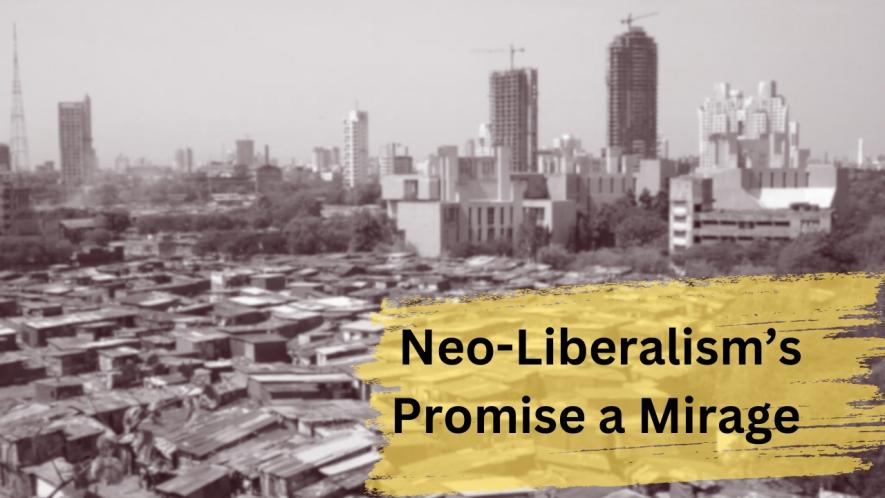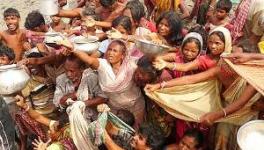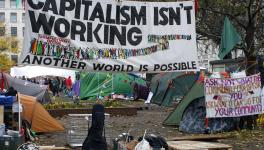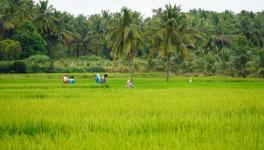Neo-Liberalism’s Promise of Milk and Honey a Mirage

Neo-liberalism propagates a set of outright falsehoods to present itself in a favourable light compared to the preceding dirigiste regime in India. The basic theme is to suggest that under neo-liberalism there has been such an acceleration of the growth rate of Gross Domestic Product that the people as a whole have become much better off, and vast masses of them have been lifted out of poverty (one particular enthusiast has even claimed that poverty now afflicts only 2% of the population). Of course, the dirigiste period was not all milk and honey, and nobody criticised it more trenchantly than the Left; but the claim that neo-liberalism represents an advance over it as far as the people’s living standard is concerned is a preposterous one.
I shall confine myself here to economic indicators alone, and not go into the massive impact that neo-liberalism has had in undermining democracy (even before the current fascistic regime), in making self-centredness and self-interest far more pervasive in society than earlier (as is to be expected under unrestrained capitalism), in giving rise to an aggrandising elite which has nothing but contempt for the poor, and in destroying the moral compass of the nation so thoroughly that it has even led to a situation where a demonstration of public anger against the worst genocide in living memory is disallowed by the government without causing media outrage.
The most tangible and tragic economic indicator is the suicide of over three lakh peasants and agricultural labourers in the last three decades, which has certainly had no precedent in post-independence India and whose roots can be traced directly to the distress into which peasant agriculture has been driven owing to the withdrawal of State support under neo-liberalism. This withdrawal is especially evident in the removal of price support for cash crops that had been available earlier, resulting in domestic prices fluctuating wildly in sync with the world prices of these crops.
While agrarian distress has reduced the number of “cultivators” by 15 million between the 1991 and 2011 censuses, pushing some peasants into the ranks of agricultural labourers and others to migrate to cities in search of jobs, the growth in employment has slowed down compared to the dirigiste era. While the rate of growth of employment has been estimated at roughly 2% per annum during the low-GDP-growth dirigiste era, which was still not high enough to make a dent on the relative size of the labour reserves that had existed earlier as a legacy of colonialism, in the neo-liberal era it has dropped to just 1% per annum which is even lower than the average rate of population growth over this period, resulting in an increase in the relative size of labour reserves. What is more, according to one estimate (CMIE) even the absolute number of employed persons has remained more or less unchanged over the last five years.
This decline in the rate of employment growth even in the face of an acceleration in GDP growth can be explained by a sharp rise in the rate of growth of labour productivity, which has been brought about by the exposure of the economy to intense foreign competition that neo-liberalism has entailed. The consequent increase in the relative size of the labour reserves has kept the per capita real incomes of the work-force more or less tied to a subsistence level, which, in view of the rapid rate of labour productivity growth, has entailed a sharp rise in the share of economic surplus in GDP. The neo-liberal period has seen as a result a remarkable increase in income inequality, and the acquiring of unprecedented prosperity not just by the big capitalists but by a thin upper stratum of “hangers on” that comprises votaries of neo-liberalism.
The extent of the increase in income inequality is evident from estimates by two French economists, Thomas Piketty and Lucas Chancel, who use Indian income tax data for this purpose. They look at the share of the top 1% in total national income, and find a decline in this share after independence to as low as 6% in 1982; after that, however, it has increased, especially in the neo-liberal period, to reach a high of about 22% in 2013-14 and 2014-15, the latest year for which they have data. At this level, the share of the top 1% was higher than it has ever been since 1922, when the income tax was first introduced in India. It is this rise in the share of economic surplus, not just in India but in the world as a whole that is responsible for creating an over-production crisis which has brought the neo-liberal regime to a dead-end.
While the per capita real income of the workforce has not increased, the rise in the ratio of the reserve army of labour to the workforce has meant an overall decline in the per capita real income of the labour-force (viz. the force consisting of the employed, the unemployed and the underemployed). It is not surprising that the relative size of those living in absolute poverty has increased. To be sure, they now have access to better common infrastructure facilities in the form of roads and streetlights, but their deprivation is evident in the decline in their per capita intake of the most elemental necessity, viz. foodgrains.
Studying poverty began in India by taking 1973-74 as the base year, and the Planning Commission took the lack of access to 2200 calories per person per day in rural India and 2100 calories per person per day in urban India as the definition of absolute poverty. Since then, all kinds of subterfuges have been adopted by the government and by institutions like the World Bank to change this definition and show a decline in poverty; but let us stick to this basic, clear-cut definition.
In 1973-74 the ratio of the rural population below 2200 calories was 56.4% and the ratio of the urban population below 2100 calories was 49.2%. This had gone up slightly for rural India to 58% and more noticeably for urban India to 57% by 1993-94, by which time neo-liberal policies had already been adopted (some date this adoption to the mid-eighties). By 2011-12 however there had been a further notable rise in poverty in both segments, 68% in rural India and 65% in urban India.
The next NSS consumption survey was carried out in 2017-18; but the figures showed such a bad situation compared to 2011, that the Modi government decided to withdraw the findings altogether. The data leaked out before the suppression of the NSS report however show an unprecedented decline in per capita real consumption expenditure on all goods and services, by 9% for all-India rural, between 2011-12 and 2017-18. The estimated proportion of rural population below 2200 calories intake, works out to more than 80% in the latter year. (These figures are taken from Utsa Patnaik’s updated report Exploring the Poverty Question submitted earlier to the ICSSR).
It is not surprising that India’s rank on the Global Hunger Index is 111 out of the 125 countries for which this index is prepared, and that this rank is lower than that of our neighbours like Pakistan, Bangladesh, Sri Lanka and Nepal.
These poverty figures are in complete sync with what overall per capita foodgrain availability data suggest. At the beginning of the twentieth century per capita foodgrain availability for British India was about 200 kg per annum; it declined steadily to about 138 kg at the time of independence, or, if we take the average for the quinquennium ending 1946-47 to just less than 150 kg. After independence this declining trend was reversed until around the end of the 1980s; but since then, per capita foodgrain availability has remained more or less constant (with a drop followed by a recovery). If we assume, reasonably, that indirect consumption of foodgrains by, say, the top 10% of the population (and we have noted that they have become richer) in the form of processed foods and feed-grains (entering into animal products) has been increasing per capita, then the per capita availability for the rest of the population must be declining.
Thus, whether we take the macro picture or the results of the consumer expenditure surveys conducted by the NSS, the consistent story that emerges is one of a rise in the ratio of persons in absolute poverty. This ratio, which is likely to have been declining in the period of dirigisme, has increased under neo-liberalism.
The propagandists of neo-liberalism not only suppress this fact but resort to various subterfuges to prove, dishonestly, that the neo-liberal era has been a period of milk and honey for all.
Get the latest reports & analysis with people's perspective on Protests, movements & deep analytical videos, discussions of the current affairs in your Telegram app. Subscribe to NewsClick's Telegram channel & get Real-Time updates on stories, as they get published on our website.























